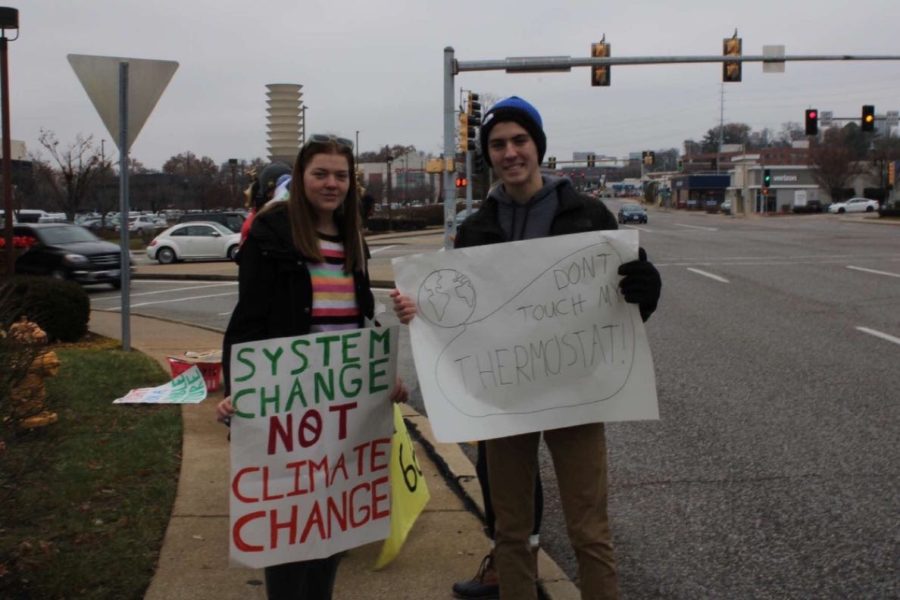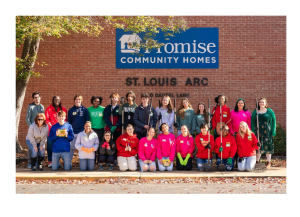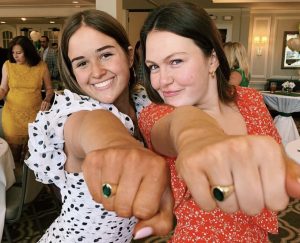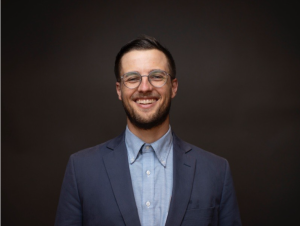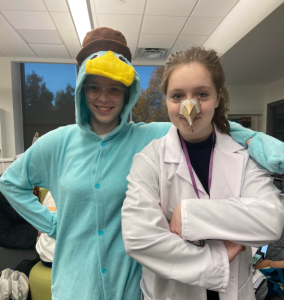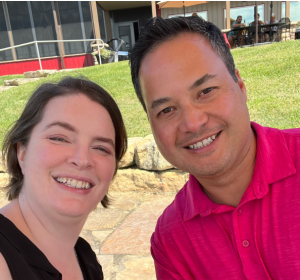Understanding Earth Day: What is Climate Change?
Grace Bradley ‘22 (Left) and her friend attended the climate march in 2019, prior to COVID-19.
April 21, 2021
Cursed climate change, the topic reigning over the eyes, and ears of Earth’s population, has repeatedly been a discussion of the future or a mere eventual effect brooding over the Earth, as a reminder of what is to come. Scientists and citizens alike review the effects of climate change, such as eventual global warming, the inevitable glacier fall, the submergence of Earth underwater, and, perhaps most frightening, the extinction of humankind, in an apprehensively futuristic manner with a slow, eventual doom. But what about climate change as a discussion of the present? How have the effects and patterns of the climate been visible in the past? Discussing climate change as not only a dark effect in the future, but also as the aftermath of the past plays an essential role in encouraging the world’s everyday people, such as students, to step up, to gain perspective, and to understand the pertinence of such a broad, pressing issue.
A study on climate change published by NASA marks the modern era of climate with the last ice age, nearly 11,700 years ago. Since then, humans have civilized, and with their civilization, brought a number of changes to the climate. According to NASA’s evidence, a majority of climate change has occurred since the mid-20th century and is a result of human activity. In tracking the patterns of the past, experts and scientists are able to see evidence of climate change in a universal temperature rise, evident in both the air and the ocean, the vast majority of shrinking ice sheets, glaciers, and snow coverage, the rising sea level, the extreme weather, and finally, the acid present within worldwide oceans.
Katie Lodes, a biology teacher at St. Joseph’s Academy, the moderator of St. Joe’s Earth Angel’s and a science enthusiast, explains that the universe is, simply put, “one big system,” and as the climate begins to change, so will the Earth, in a variety of different ways.
“I think that we’re starting to see things that aren’t conducive to how people survive and that can be worrisome,” said Lodes. “I do believe that people are smart and can figure out ways to mitigate this.”
The increasing evidence of climate change’s existence not only shows how the climate has changed in the past few years but also what specifically will happen when it does change. In a way, this is perhaps the most pressing question, as it calls to mind the numerous effects of climate on everyday people and encourages their interest in the topic. As a variety of organisms across the globe continually migrate due to home destruction, humans can only imagine the coming detrimental effects of climate change.
Mrs. Lodes continued her discussion about Climate Change.
“Climate is the long term. We will see a disruption in the living part of the world. Not only will it affect us, but there are only so many places an organism can go. Sometimes it’s hard to say ‘I need to make changes’ to prevent it from happening, but it’s definitely happening,” explained Lodes.
Currently, according to NASA’s research on global climate change, the long-term, drastic effects of Climate Change are already appearing across the Earth, taking on a variety of different forms. For example, NASA finds that the Earth’s surface temperature has risen about 2.05 degrees, allowing the ocean to absorb this heat, with about a 0.06-degree increase in temperature, as well as a sea-level rise of about eight inches. Every day citizens of Earth look to their environment when the weather is supposed to be getting colder, and they see the difference.
Countries around the globe have taken initiative in creating a solution to preventing change, as the UN repeatedly reminds the world that there is in fact a solution. The United Nations calls countries around the globe to honor the Paris Agreement, an agreement centered around global action in Climate Change, encumbered by the pursuit of keeping the global temperature rise beneath 2 degrees celsius. As the United States withdrew from the Paris Agreement, the nation faced a variety of backlash; however, there are still a variety of figures and climate activists to look to for advice.
Grace Bradley, President of St. Joe’s Earth Angels, and a practicing climate activist searches for political activism in the American government.
“I would consider United States Representative Alexandria Ocasio Cortez and Senator Ed Markey to be good role models. They co-authored the Green New Deal, and though controversial, it is very well thought-out. A national-scale plan like this is necessary to combat climate change and ensure that no one is left behind,” discussed Grace.
According to a study from the Pew Research Center, 67% of United States adults believe that the federal government is doing too little, asserting that the solution to climate change is in the hands of everyday people.
“The real change begins in our homes,” continued Bradley, in regards to everyday people taking action.
Attempting to make changes within the home, though challenging is the key to increasing government involvement and the action of large-scale corporations. Students, teachers, and other people around the globe must continue to talk about Climate Change, in the most effective way possible. Talking about Climate Change, with a solution in mind will inevitably lead to action from other peers.
Grace Kelly, a student at St. Joe and a speaker against Climate Change, discusses with her peers the different ways in which she can take action, even within her own home.
“It’s all about the little things,” Kelly stated. “A reusable water bottle, thrifting, modified veganism, such as decreasing meat and dairy in a given diet, and perhaps, even growing a home garden, are just several ways to take action against a much larger issue.”
All in all, Climate Change is an issue of drastic effect, obvious in the present as well as the future. It is the responsibility of everyday people- young and old- to take action in whatever ways possible.
In the words of Grace Bradley: “It’s about allowing yourself not to be perfect at sustainable practices, but attempting as best you can, and as often as you can to rise against this issue.”



